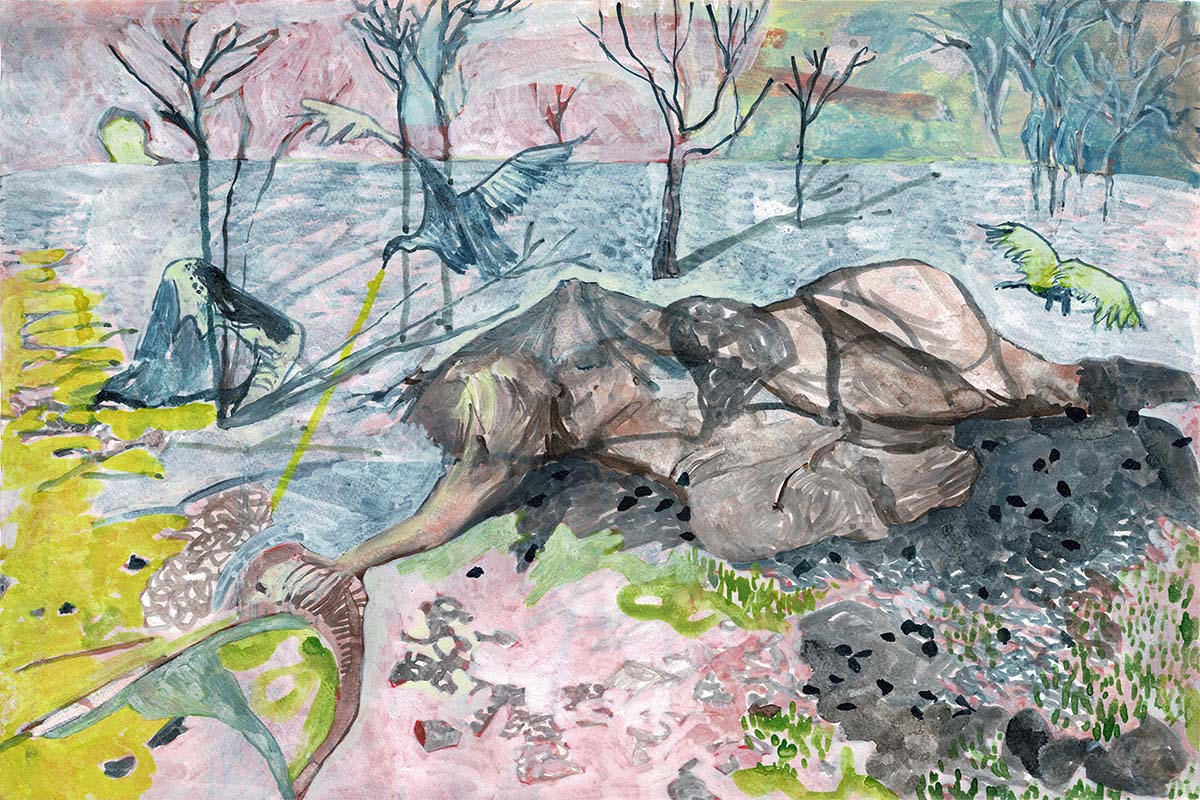Lorenzo Aceto
alba adriatica
Spazio Sei, Pescara (I)
June — September 2023

alba adriatica
Daniele Capra
Lorenzo Aceto’s personal exhibition alba adriatica features a dozen recently created works by the artist. The project, titled after the name of a small Abruzzo town, refers to the idea of rebirth and has emerged forcefully from Aceto’s personally intense emotional experiences. The artist was struck by the loss of his parents and the joyous birth of a child in close proximity and, within a few weeks, he transitioned from a state of melancholy and pain caused by the loss to the sweetness of a new life entering the world. Joy thus intertwines with nostalgia and merges with the heavy weight of grief, creating a state of great emotional instability. Through this show, Aceto highlights the sense of fragility and uncertainty of the human condition, in a continuous alternation of contrasting emotions.
The artist’s practice is characterized by the almost exclusive use of painting and an essential figurative style, consisting of synthetic and vigorous brushstrokes. Nature and animals are recurring subjects in his works, often placed in desolate, dark, and enigmatic landscapes. The exhibited works range from oil paintings to watercolours, from drawings on paper to video, with concise and essential charcoal works blending with large-sized paintings and fluid watercolours. The depicted subjects are stripped of any representational emphasis and exist ambivalently on the surface, either fixed by sharp black marks or almost liberated by liquefying ethereal colours.
In Natural History Pliny the Elder reports that the practice of painting originated from an insight by Callirrhoe, perhaps the first recorded female artist in history. Using a lamp, Callirrhoe traced the outline of her lover on the wall with a charcoal before he embarked on a long journey. That portrait, that dark trace on the surface, replaced, at least in part, the beloved person. It was the record of his presence, of his previous passage there, and by its resemblance that drawing was capable of evoking the existence of the beloved beyond the physical location where he was at that moment. The dry sketch drawn by the Greek artist conveyed the possibility of somehow duplicating oneself, being in multiple places at the same time, at least ideally. Painting, indeed, allowed evoking a person visually and emotionally in a place, although it was not possible in the concrete reality.
Pliny’s account, clearly not realistic in nature, nevertheless highlights a significant aspect. Namely, the fact that painting may have originated from a lack to participate on behalf of someone else, and through its physicality in order to alleviate the pain of a separation that would otherwise be difficult to bear. The painting occupies the place of someone/something that is temporarily (or absolutely?) not with us: it narrates, like literature, an elsewhere that is distant from here and now, yet finds space within us and inhabits our thoughts. That painting, like perhaps all paintings, fills an absence, fills psychologically a void that was created. It is precisely from the desire to fill the absence of what was previously and no more exists that Aceto started working on alba adriatica, in a process where emotionality is inseparable from the practice of painting.
alba adriatica is the result of the artist’s introspective exploration of his own past, evoking the people who have left us and the events that can no longer occur, in the serene awareness of the transitory nature of situations and presences in our lives. Aceto paints because painting is the closest and natural medium in order to fill the void, to not forget those who are no longer present, such as deceased parents or loved ones. And in this context, the artworks serve as physical supports on which this process of grief, evocation, and memory is recorded. The continuous intertwining of artistic practice and life leads to the merging and blending of events in his own existence, as evidenced, for example, by a Super 8 video of his family showing the lights of a chandelier. The present moment is never an immediate offspring of the instant: it is the sum of everything that was before that disappeared. Thus, the pictorial present that Aceto presents is profoundly veiled by the shadows and lights of the past, allowing us to be human, as it enables us to understand who we are and where we come from.
Aceto’s artworks capture the coexistence of asynchronous elements: the past and its distance, the loss, the pain of absence, the attempt to revive that past by depositing one’s emotions, and the time of oil painting, which itself is based on a layered execution time. In his works, time experiences a coinciding multiplicity, where memory fades and disperses while life attempts to resurface before our eyes, albeit transiently. The artist’s austere and intense painting is simultaneously an act of responsibility towards memory and a gesture to celebrate life – which, despite everything, continues to pulse incessantly. Although dissolved in the most delicate oil colours or the most vibrant cadmium yellow.